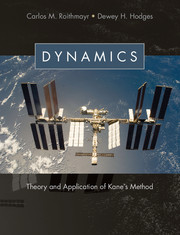Book contents
- Frontmatter
- Contents
- Preface
- Preface to Dynamics: Theory and Applications
- To the Reader
- 1 Differentiation of Vectors
- 2 Kinematics
- 3 Constraints
- 4 Mass Distribution
- 5 Generalized Forces
- 6 Constraint Forces, Constraint Torques
- 7 Energy Functions
- 8 Formulation of Equations of Motion
- 9 Extraction of Information from Equations of Motion
- 10 Kinematics of Orientation
- Problem Sets
- Appendix I Direction Cosines as Functions of Orientation Angles
- Appendix II Kinematical Differential Equations in Terms of Orientation Angles
- Appendix III Inertia Properties of Uniform Bodies
- Index
Preface
Published online by Cambridge University Press: 05 February 2016
- Frontmatter
- Contents
- Preface
- Preface to Dynamics: Theory and Applications
- To the Reader
- 1 Differentiation of Vectors
- 2 Kinematics
- 3 Constraints
- 4 Mass Distribution
- 5 Generalized Forces
- 6 Constraint Forces, Constraint Torques
- 7 Energy Functions
- 8 Formulation of Equations of Motion
- 9 Extraction of Information from Equations of Motion
- 10 Kinematics of Orientation
- Problem Sets
- Appendix I Direction Cosines as Functions of Orientation Angles
- Appendix II Kinematical Differential Equations in Terms of Orientation Angles
- Appendix III Inertia Properties of Uniform Bodies
- Index
Summary
The authors of the earlier version of this book succeeded in accomplishing the goals stated in their preface. Since it was written, Dynamics: Theory and Applications has served as a textbook for teaching graduate students a method of formulating dynamical equations of motion for mechanical systems. The method has proved especially useful for dealing with the complex multibody mechanical systems that in the twentieth and twenty-first centuries have challenged engineers in industry, government, and universities: the Galileo spacecraft sent to Jupiter, the International Space Station, and the robotic manipulator arms aiding astronauts on the Space Shuttle and International Space Station are but a few examples. Kane's method is systematic and easily taught, in a way that enables the student to be conversant with colleagues trained to apply traditional approaches found in the classical literature.
Although the fundamental aspects of the method have not changed during the past three decades, advances and refinements have been made in a number of areas. In certain cases the newer developments facilitate exposition of the topic at hand and lend themselves well to integration with material in the original textbook. The primary purpose of this text, then, is to make the benefits of this progress available for current courses in dynamics.
The preface to the earlier version (which immediately follows this Preface) includes a discussion of the organization of the original book and supporting rationale. Here, we give an overview of the modest alterations made to the earlier structure.
The initial chapter now begins with three brief sections that put the student into position to give a mathematical description of the orientation of a rigid body with respect to a reference frame, when the rigid body has been subjected to successive rotations. Inclusion of these sections provides a formal presentation of topics that typically were covered in classroom discussion. The final section of the first chapter is concerned with differentiation of a scalar function of vectors, which subsequently comes into play in Chapter 6. The original second chapter is divided in two; Chapter 2 deals solely with kinematics, and Chapter 3 is devoted to constraints. The separation focuses attention on the subject of constraints, where there are important distinctions to be made between Kane's method and the classical approaches.
- Type
- Chapter
- Information
- DynamicsTheory and Application of Kane’s Method, pp. ix - xPublisher: Cambridge University PressPrint publication year: 2016
- 1
- Cited by



